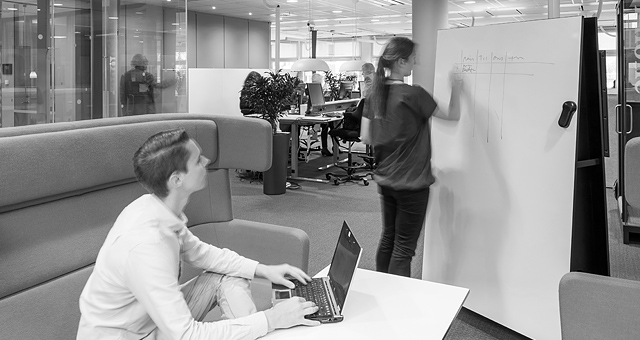
Curious about activity based workspaces? Here are the most common pitfalls
Offices now play a crucial role for many corporations and public bodies. Nowadays, we understand the exceptional impact the working environment has on working methods, job satisfaction, productivity and progress. The realignment towards activity based solutions is becoming more common, and we highlight the most common pitfalls.
Long-term experience of multiple office projects and the results of study and research in this segment have brought Carina Hörnfeldt Bylund a clear perception of what we need to bear in mind to make this change successful, and what should be avoided. According to Carina, one of the big problems is that many companies view this realignment as a furnishing and relocation project, rather than a change project.
"Implementing activity based workspaces means that people have to work in a new way, and this must have their support. Managers must also respect the fact that different groups work in different ways and plan offices to suit everyone," explains Carina. We asked Carina to list the most common pitfalls when implementing activity based office solutions. Here´s the list.
It's a change project rather than a furnishing and relocation project.
The most common pitfalls when implementing activity based offices
#1 — Insufficient adaptation to operations
A lot of relocation projects start with managers making research visits to other offices and replicating existing solutions. Often, the result is dissatisfied staff, and solutions then having to be altered, which is expensive and unnecessary. While starting from “best practice” is good, solutions must also proceed from your own individual operation. Accordingly, different needs and working methods require a good feasibility study, including objective measurements of occupancy and qualitative, in-depth interviews. This will generate good supporting data that illustrates your operation’s actual needs.
#2 — People must understand what and why
As in every change process, it’s vital that the people affected by change are well prepared. Worries and questions ahead of a change are natural, and must be dealt with. Affected staff need to understand what’s happening and why. Continuous information and openness are vital. Information from management is obviously central, but this often needs to be supplemented by information via a display stand, breakfast meetings on various themes, or perhaps a dedicated website. Displaying sketches ideas and plans, and arranging short training sessions in using the office are all good types of preparation. Engaging people by voting on room names, choosing themes etc. can also generate a positive reception.
#3 — Adapt your leadership to the circumstances of the new activity based workspace
Managers play an important role as information-bearers and change leaders ahead of relocations, but they also need to be prepared for the change leadership required in an activity based workspace. How will the team work when they are no longer co-located geographically? How will meeting structures be affected? What are the objectives of the new office? These are questions that managers can and should think about before the relocation, so the team is prepared for the changed working methods.
#4 — Ensure the transition to a functioning admin organization
There’s often a well-defined project team responsible for solutions in the new space and the actual relocation during the planning and relocation process. This team often dissolves after the actual relocation is complete, but it’s important that there is an organization in place to continue working to optimize the new workspace. A good office is an office that is continuously adapting to its needs. A clear structure runs this work, and in the best of all worlds, how space is being used, job satisfaction in the office and how well the office supports day-to-day operations is continuously monitored. By continuously calibrating and adapting the office to operations, the potential for continuously high job satisfaction and increased productivity is created.

